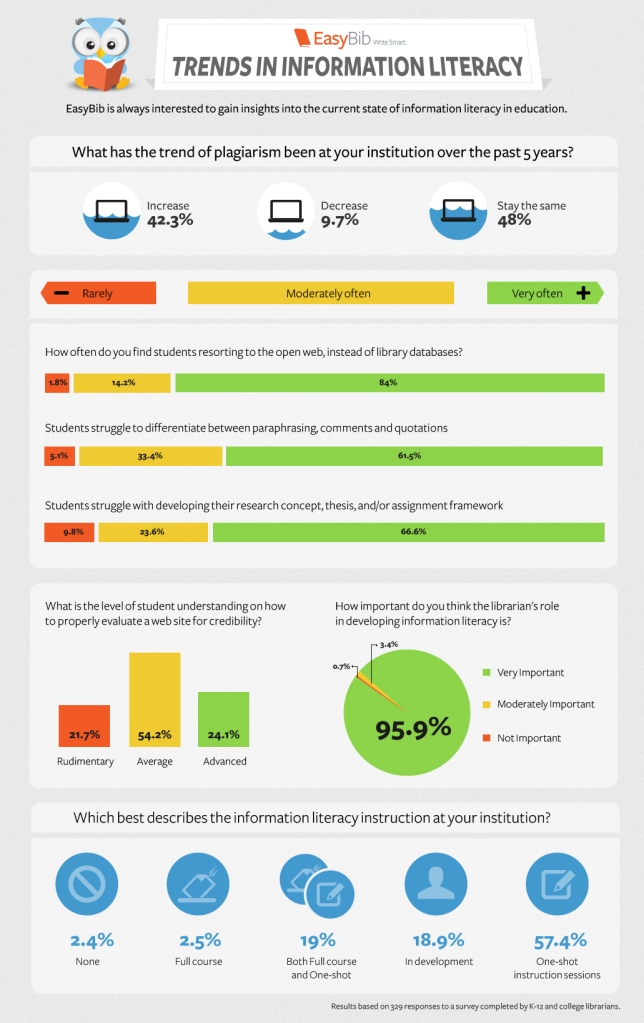Dec
2014
Digital Literacy for St. Cloud State University
http://content.easybib.com/tips-for-teaching-digital-information-literacy/#.VH4eeTHF_To
http://content.easybib.com/digital-literacy-and-web-literacy-whats-the-difference/
http://content.easybib.com/resources-for-teaching-digital-web-literacies
the challenge of social media with respect to information literacy is that networked individuals are continually bombarded with information. Thus, information literacy’s importance must make the leap from the academic world, where purposeful information search is the norm, to “real life,” where information continually competes for the audience.
http://content.easybib.com/infographic-information-literacy-issues

http://www.rochester.edu/pr/Review/V68N1/inrev15.html
The premise of information literacy is that the supply of information has become overwhelming, and that students need a rigorous program of instruction in research or library-use skills, provided wholly or in part by librarians.
The idea behind information literacy is that our typical freshman is drowning in information, when in fact Google provides her with material she finds good enough, and does so instantaneously. Information literacy assumes that she accepts unquestioningly the information she finds on the Internet, when we know from research that she is a skeptic who filters her results to the best of her ability. Information literacy tells us that she cannot recognize when she needs information, nor can she find, analyze, or use it, when she demonstrably does all of those things perfectly well, albeit at a relatively unsophisticated level.
Simply put, information literacy perceives a problem that does not exist. Furthermore, it misses the real threat of the Internet altogether—which is that it is now sufficiently simple and powerful that students can graduate without ever using the library. That is unfortunate because, for all its strengths, the Internet cannot give students the high-quality scholarly information that is available only through subscription, license, or purchase.
As Roy Tennant noted in the January 1, 2001, Library Journal, “only librarians like to search; everyone else likes to find.” Any educational philosophy is doomed to failure if it views students as information seekers in need of information-seeking training.
Information literacy is also harmful because it encourages librarians to teach ways to deal with the complexity of information retrieval, rather than to try to reduce that complexity.
“The library is a place where readers come to write, and writers come to read.” Dow casts students not as information seekers, but as apprentices engaged in a continuous cycle of reading and writing.
Librarians should use their expertise to deepen students’ understanding of the disciplines they study. My note: ant that’s why LRS needs area specialists, not traditional librarians.
The library must also do a better job of reaching more students, more often. Librarians need to use their expertise to make the library’s online presence approach the simplicity and power of the Internet.
about early adults and their research habits
http://ed.ted.com/lessons/the-brilliance-of-bioluminescence-leslie-kenna
the problems is, most companies today are run to minimize risk, not maximize freedom and speed
don’t base your venture on a plan, instead base it on a strategic foundation
http://www.cnet.com/pictures/apples-refreshed-ipad-line-pictures/
Apple created the A8X processor specifically for the iPad Air 2. The new chip has a second-generation 64-bit architecture, houses 3 billion transistors, and compared to the iPhone 6‘s A8 chip, has a 40 percent faster CPU, while its GPU is 2.5 times faster.
rear 8-megapixel iSight camera boasts a new sensor to capture 3,264×2,448 resolution photos and 1080p HD video.
Apple added an impressive anti-reflective coating to the iPad Air 2, which allegedly reduces glare by 56 percent.
http://www.edtechmagazine.com/k12/article/2014/10/review-microsoft-surface-pro-3-packs-punch
250-gigabyte hard drive, the Surface Pro 3 offers 15GB of online storage through Microsoft OneDrive
12-inch screen’s 3:2 aspect ratio
Intel Core i5 that could crunch large Adobe Photoshop and Microsoft PowerPoint files with ease
Educator and librarian Shannon Miller recently provided the definition of “digital citizenship” to Flocabulary (http://www.flocabulary.com/)
http://www.pinterest.com/search/pins/?q=oversharing&term_meta%5B%5D=oversharing|typed
http://blogs.edweek.org/edweek/DigitalEducation/2014/10/screen_time_early_learners_RAND.html
screen time as the sole measure of what’s OK for children is no longer adequate, the RAND researchers argue that screen-time limits shoudn’t go the way of the VCR:
Limits on screen time may remain important in restricting use that is passive, sedentary, or noneducational, and they may also prove useful in ensuring that children engage in a balanced combination of activities.
However, a more-comprehensive definition of developmentally appropriate technology use will empower ECE providers and families to make better decisions about the ways in which young children use technology–and help maximize the benefits young children receive from this use.
my note: information on Pinterest still goes the other direction. E.g.:
http://www.pinterest.com/pin/284923113897755173/
